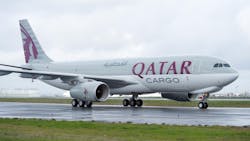NASA asks industry for machine autonomy technologies to enable nationwide unmanned air cargo operations
MOUNTAIN VIEW, Calif. – U.S. aeronautics researchers are approaching industry for enabling technologies necessary to fly large unmanned aerial vehicles (UAVs) widely to deliver large amounts of aerial cargo throughout the nation.
Officials of the National Aeronautics and Space Administration (NASA) Ames Research Center in Mountain View, Calif., issued a request for information (RFI) last week (80ARC020ATMXPAAV) for the Pathfinding for Airspace with Autonomous Vehicles (PAAV) project, which is part of the NASA Air Traffic Management-eXploration (ATM-X) program.
The PAAV project involves the seamless, scalable, integration of large UAVs for cargo transportation between traditional airports and other national airspace access points.
Unlike the use of small UAV for package delivery, these large UAVs will be able to move large amounts of air cargo regionally or nationally, using automated technologies for UAV cargo operations.
From industry, NASA researchers want to learn about plans to invest in UAV cargo operations, understand the challenges involved, and help NASA find ways to engage industry on this topic.
NASA wants to forge industry partnerships to help formulate concepts of operations for commercially viable UAV cargo operations to help guide NASA research and conduct flight demonstrations as early as 2025.
NASA researchers want to determine if there is sufficient industry interest in UAV cargo operations for more investment; find out about industry plans for UAV cargo operations; and estimate costs.
A key goal of a PAAV flight demonstrations is to demonstrate procedures and technologies necessary for gate-to-gate file and fly UAV cargo operations in the U.S. national airspace system.
Related: Artificial intelligence (AI) in unmanned vehicles
NASA experts want to learn about industry developments in machine autonomy to conduct surface operations, collision avoidance, and how to manage contingencies like lost data links in unmanned commercial air cargo operations.
The PAAV demonstration will use industry-provided aircraft with optionally piloted, manned surrogate, and remotely piloted capabilities that could enable gate-to-gate UAV cargo operations. Aircraft and autonomy technologies used in the demonstrations should be on a development path toward certified systems.
The PAAV demonstration is to help develop concepts of operations that identify future needs and enabling technologies for integrating automated cargo operations into the national airspace system.
NASA experts also want to learn about technological barriers to routine file and fly automated cargo operations; identify automated functions necessary for scalable automated air cargo operations; and examine necessary changes to existing roles and responsibilities between humans and automated air cargo systems.
Potential NASA partners on this project include UAV manufacturers; air cargo operators; UAV avionics and middleware industry representatives; software companies supporting UAV operations; sensor manufacturers; communication, navigation, and surveillance providers; ground station system developers; and others who have capabilities to enable UAV operations in the national airspace system.
Companies interested should email responses no later than 29 Jan. 2021 to NASA's Rober Fong at [email protected]. More information is online at https://beta.sam.gov/opp/ccca91897cb94032831b472ad9c0ad9e/view.
About the Author
John Keller
Editor-in-Chief
John Keller is the Editor-in-Chief, Military & Aerospace Electronics Magazine--provides extensive coverage and analysis of enabling electronics and optoelectronic technologies in military, space and commercial aviation applications. John has been a member of the Military & Aerospace Electronics staff since 1989 and chief editor since 1995.
